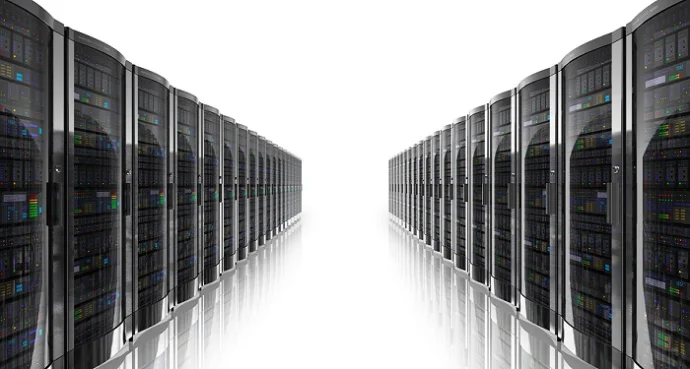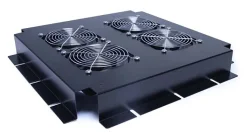How To Choose A Server Cabinet
There are many challenges to installing the right server room racks and cabinets for your IT facility. If you don’t have a datacentre floor but have to focus on a small server room or back office or network closet, space in terms of footprint and ceiling heights can be challenging factors. These small data environments typically have less than ten or less server racks housing their servers (now virtualised), network hardware, telecomms and storage devices.
When it comes to selecting a sever cabinet the choices available can range from open frame racks to server cabinets with side and front and rear doors. Enclosures can also be wall mounted to help optimise space. Of course, as with any network installation, future growth must be factored in as this will affect floor space, airflow, cooling capacity, power protection plans (in terms of UPS system backup), cable management, fire suppression and access security.
Server Cabinet Depth and Height
When designing your server room layout one of the first things to consider is the depth and height of the equipment that you will place into the rack. IT servers and associated networking hardware comes in a varying degree of depths (measured in milli-metres). The deepest depth will then define one of the factors you need for server cabinet selection. Care needs to be taken here to ensure you allow sufficient depth for cable bend radius and if you are going to use a UPS system and power distribution units (PDUs).
Most smaller uninterruptible power supplies are available up to 10kVA in a 19inch rackmount format. The UPS will have a depth in mm and may have an internal or external battery pack that should also be calculated into the overall required U height. If you are using PDUs, these may be horizontal or vertically mounted on the front or most likely the rear pillars of the cabinet.
The next task is to add up the height of the rack mount systems. This is generally measured in U where 1U=44.45mm. If you have a tower cabinet to install this can be installed by adding a shelf to the server cabinet and you can make then convert the tower height (in mm) to U.
Once you have the depth and U requirements you can select a cabinet size. These tend to vary from around 12U to 48U or more in height. Another recommendation is to plan the U height in terms of how you will populate the cabinet. Lighter systems should be placed nearer the top of the cabinet and heavier systems (including UPS systems) near to the floor. This helps to stabilise the rack and prevent the system’s centre of gravity changing if a system is drawn out of the rack. Also, weight must be considered in terms of whether to use slides or a shelf. Slide runners fix to the server cabinet pillars and equipment to be housed and allow the equipment to be pulled-out for access. Shelves are more rigid and can take more weight generally.
Power and Data Cable Routing
Once you have a final layout plan it is also worth consider cabling (data and power) layout and the overall cabinet weight. Correct cable management includes clear routing and cable labelling whether its power or data cables. If your cabinet is on show, neat cable routing can demonstrate attention to design and detail but can also reduce system downtime, improve airflow and prevent potential errors when removing or plugging in new equipment and cables.
It is possible for a server cabinet when fully populated to have a weight up to 300Kg. When not installed on a ground floor, this level of weight may require a check with a local structural engineer to ensure that the floor can take the overall weight. The engineer will look at single point loadings (on the server cabinet feet or castors) and may recommend either a spreader plate or floor strengthening or for the cabinet to be more to a different part of the building.
Cooling and Airflow
Cooling and air flow will always be important when selecting a server cabinet due to the amount of power the latest servers draw. A typical server cabinet, fully populated can see 10kW of power in wasted heat generated from the equipment within it and this heat needs to be removed and cooled to prevent overheating, damage and a potential fire risk. Servers and server cabinets have temperature ranges they require and in smaller server rooms you may decide to install an in-rack air conditioner or in-row air cooling system. Wall mount air conditioners are also an option where space is restricted.
If a UPS is installed in the room or within the server rack itself, this can also add to the overall cooling capacity required. The UPS will have an internal or external battery set. Whilst the UPS can probably operate up to 40°C without degradation, the battery set will require an ambient temperature of 20-25°C to meet its design life. In a typical UPS system below 10kVA for a server room environment this can be 3-5 years if the battery is a sealed lead acid valve regulated (VRLA) type.
Overall airflow and cooling efficiency within the server cabinet will depend on heat loading and the potential for cool air to leak out of the planned exhaust stream. To prevent leakage, blanking plates should be fitted to any area of the cabinet that is not populated or exposed.
Security and Monitoring
For the overall room security and access should also be considered as should overall environmental monitoring. If the server room is typically locked with a code-access or card system, any single piece of hardware within it be it a server, storage device, UPS system or air conditioner could be generating an alarm, triggered by a failure or because of a self-test routine.
All systems should be connected to the local network via an SNMP/IP connection and preferably to an overall environment monitoring solution. Either system should can generate alarm messages via email or SMS text or pre-recorded voice messages when an alarm condition occurs. Whilst the size of the room may not warrant a fire suppression system, smoke detectors could announce any heat build-up problems and a local fire extinguisher with the right extinguishing agent should be nearby if not in the room itself. Some companies also now offer an in-rack fire suppression system and this can be useful for unmanned sites.
The final considerations for a server rack cabinet relate to the cleanliness of the environment itself. Whilst server cabinets are generally design and built to an IP20 level, higher IP ratings are available. IP stands for Ingress Protection the higher the number the more the protection provided. Dust filters can be added to a server cabinet, alongside drip protecting roofs, special anti-corrosive paint finishes for external, onboard ship and high humidity area usage.
Finally, always remember logistics. Once you have selected a server cabinet, you need to get it to site and positioned. Most server cabinets can be supplied completely built-up or in semi-knock down kicks for ease of transportation and placement. Whilst a semi-knock down kit will take time to build up on site, it makes for an easier delivery and placement on site where it can be fully populated once in position.

























